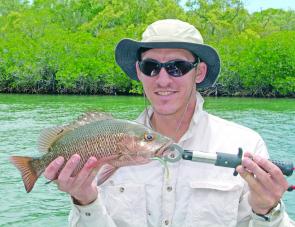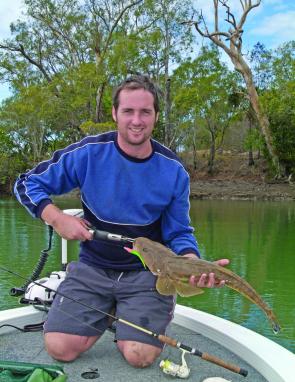As the boat rounds a sharp bend, you see your favourite set of snags in the distance. A couple of big fallen trees, a smattering of boulders and a steep rocky bank provide the perfect ambush point for fishy thugs like estuary cod, dusky flathead and mangrove jack. With the snags only about twenty metres away, you back off the electric and the boat holds position against the ebbing tide. Now you need to make a decision: do I use soft plastic, hard body, surface, sub surface, floating or sinking lure? While not always a straightforward decision, preparation and versatility can allow for an effective presentation that will tempt a range of predatory species.
The sudden jolt when a lure is slammed, not knowing precisely what the culprit is, makes saltwater estuary fishing exciting, diverse and very rewarding. Trying to cater for a host of different species can be difficult, but a happy medium can be found where most situations can be handled by having a few well set up outfits.
I would like to share my 3 combos I always have on hand when fishing in the estuaries, as well as the associated lines, leaders and lures that will see you getting the most out of your time on the water. In their most basic forms the three combos fall into these categories: a light spinning outfit, medium spinning outfit and a heavier baitcast setup. Having three separate combos rigged up and ready to go will not only save time but allow you to work snags with different lures and learn to select a presentation that suits a particular structure type.
In my boat this is the outfit that sees the most use. Using smaller lures will draw strikes from a number of different sizes and species of fish. When the bigger fish don’t want to play, you’ll still get plenty of action from fish like bream and small trevally. Also, while bigger fish have little hesitation in hitting snack size lures, getting a bream to hit a 4-5” plastic or hardbody can be difficult.
The light spin outfit is a great searching tool because longer casts can be made. They are comfortable for extended use and when using plastics the entire water column can be targeted effectively. Usually I tie on a 3” plastic with a 1/8 or 1/12 ounce jighead, depending on how much current there is. This presentation works best when you are casting to bankside eddies, mouths of small drains and creeks, vertical structures like rock and the edges of mangrove stands. Because these areas don’t have excess points for snagging the exposed single hook provides a good hook-up ratio without lure losses getting too high. When working bigger snags, rock bars or rough bottom structures, try and work the lure either side of the structure on a controlled sink or erratically flick and dart the lure over the top.
A small popper is another option early or late in the day and can provide some spectacular visual strikes. Poppers also have the advantage of being able to be worked over the top of heavy structure and over shallow areas with rocky or snaggy substrates. You’ll probably lose the occasional good fish but it is surprising how often steady pressure can draw fish like estuary cod and average jacks out of their lairs.
This rig is definitely the most versatile as you’ll be able to catch bream one cast and barra the next. Small soft plastics, minnow lures and prawn imitations can all be cast accurately to structure with a good blend of finesse delivery and extraction power that is needed around dense snags. A fairly light tip with a heavy butt section gives good casting ability as well as bottom end power. The predominant lures presented on this outfit are 4-5” plastics, weedless rigged plastics, Prawnstar Juniors and diving minnow lures. Jighead rigged plastics are utilised similarly to those used with the light spin outfit.
Medium spin tackle really excel when casting snag-resistant offerings into heavy structures. Prawnstar and Texas-rigged (snagless) plastics can be put right in front of fish sitting deep in spindly snags and rock patches. Allow the lure to sink right into the structure until it hits the bottom before starting the retrieve. Prawnstars get the best results when worked with an alternating subtle lift/heavy flick retrieve, where the lure bumps and bashes its way out of the structure.
Soft plastics can be more effective using a series of small intermittent flicks while slowly retrieving line onto the spool. With either method strikes come hard and fast and a brutal high pressure approach is needed to extract the fish. Occasionally a snagged fish can be coaxed out by taking pressure off the line and waiting to see if the fish swims out to open water. Snagless rigged plastics require an exaggerated hook set when a bite is registered to pull the hook through the plastic into the fish’s mouth. Some days hook-ups come easily but on others it can be a very frustrating exercise. Minnow style lures can be cast to structure, wound to depth then a repetitive flicking action is used while minimising line retrieval. This keeps the lure in front of both the fish and structure as long as possible. A slow steady retrieve once the lure is out of the strike zone can still get whacked so concentrate all the way through the retrieve.
I know some people out there will be saying ‘You don’t need a baitcaster!’ but I honestly believe they are the best tool for delivering minnow and heavy soft plastic lures to structure and then removing hard-fighting fish once they’re hooked. The accuracy, drag power and ability to cope with heavy braided line ensure baitcasting reels remain an integral part of my fishing arsenal.
There are a number of scenarios when the baitcaster comes out in favour of the lighter spinning outfits. The most obvious is when I’ve been busted off on the lighter gear and I think more fish of a similar calibre are around.
When casting hard body lures to prominent snags, a baitcaster provides supreme accuracy and the ability to lock up on fish close to cover. When smaller lures have drawn a blank on the structure that you feel must hold some fish, sometimes a bigger lure can draw an aggressive strike when repetitive casts are made to a particular piece of structure.
Hopefully this article has given you a few ideas how to best target fish in your local estuary. Swapping between different outfits and techniques will improve your proficiency at each method and you will get to know which outfit to use and when. So when you round that corner and see the perfect structure feel confident in the knowledge that you’ve got what it takes to get the most out of your fishing. – John Loeskow
Facts
LIGHT SPIN
6’6” and 7’ (2 and 2.1m) Graphite Spin Rod
1000 and 2000 size spin reel
4-6lb Fireline (Pink or Green)
6-10lb fluorocarbon or monofilament leader
Suggested Lures:
Berkley Powerbait 3” Bass Minnow (Dropshot) Pearl Olive, Smelt, Pumpkinseed
Berkley Gulp 3” Minnow Smelt, Chartreuse
Squidgy 85 mm Flickbait Evil Minnow
Berkley Gulp 2” Shrimp New Penny
Ecogear SX40 or SX 48
Tackle Tactics 1/12 or 1/8 oz #1 Jighead
Nitro 1/8 oz #2 Bream Pro Jighead
Sunline FC EGI Leader 8lb
Berkley Vanish Leader 6 lb
MEDIUM SPIN
6’6” (2 m) Graphite Rod
2500 and 4000 size Spin / Eggbeater Reel
10lb Fireline/10lb Line System Bass Hard PE Braid
12lb and 20 lb Fluorocarbon Leader
Suggested Lures
RMG Scorpion 68 3.1m Gold, Mullet
Prawnstar Junior Honeypot, Bloodup
Berkley 4” Powerbait or Gulp Minnow Smelt, Pearl Watermelon
Berkley Powerbait 4” Shrimp Natural, Tequila Gold
Tackle Tactics 1/8oz 2/0, 1/6oz 3/0 H Jighead, 1/8oz 2/0 Snagless Weight System
Nitro Saltwater Pro 1/6oz 3/0 Jighead
Sunline FC Rock 12 lb Fluorocarbon Leader
Berkley Vanish Leader 20 lb
HEAVY BAITCAST
5’4” and 6’2” (1.65 and 1.9 m ) Graphite Rod
200 Low Profile or Barrel style Baitcaster
20lb and 30lb braid (FINS, Bionic, Sufix)
40lb and 60lb Fluorocarbon or Hard Monofilament Leader
Suggested Lures
Tilsan Barra 80mm 3.5m Jaffa, Fingerling, upgrade hooks to VMC 3x #2 or Owner ST #2
Barra Classic F18 2.5m Gold Dazzler, Grey Ghost
Berkley Gulp 5” Jerkshad Smelt with TT 1/6oz 4/0 Snagless Weight System or 1/4oz 3/0 H Jighead
Berkley Vanish Leader 50lb
Sunline Line System Leader FC 50lb

A nice jack caught on a medium spin outfit fishing plastics over structure in deep water.

Quality flathead lurk in the deeper holes where baitfish school in big numbers. Russell Street snared this 55cm dusky on a 5” Gulp in nuclear chicken.




